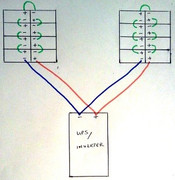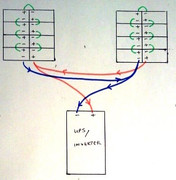During proof reading this I became aware this post may be a bit lengthy. Maybe go fetch a coffee, get cumfy, whatever, before reading further?
So often I hear of people adding extra batteries to their UPSs (or inverter setup) but these batteries do not last their typical lifespan (let?s say 2 to 3 years for the average UPS) or fail to deliver a constant battery power back-up time during normal service. I say normal service in the sense that these batteries do not run the UPS until the batteries are dead flat, which as we know damages the average battery. To ensure proper charging and discharging (normal use of) these batteries should be balanced charged and balanced discharged.
I have just completed doubling the battery capacity of one of my UPSs. I thought I would share how I did this. (Sketchy diagrams below)
Factory fitted the UPS comes with eight 12volt 7.2Ah batteries fitted within it. This particular UPS I use on a desktop computer which originally started off as a high end gaming machine. With the computer tower, 2 monitors, desk lamp, DAC, headphone amp and a wifi modem all running at once I got just over 2,5 hours battery backup time off the UPS. 2,5 hours is longer than the average loadshedding time here in Durban, but running the batteries that low drastically shortens the overall life expectancy of the batteries. This prompted me to double up on batteries as typically those of you in the know understand you need twice the battery capacity to that of your needs.
This UPS has the eight batteries wired in series to deliver 96 volts to the inverter board. Without 96 volts the UPS will not run. Other UPSs typically require either 12 or 24 volts before they will switch on.
But wait. What is series?
(?think of a TV series?one episode feeds and follows through into the next episode and so on and so on?.) Series is when you connect the ?+? terminal of the first battery to the ?-? terminal of the matching battery alongside it, and you repeat this pattern of connections until you have a single battery terminal that is not connected to anything on both the very first battery and the very last battery. These unconnected battery terminals are the ones used to connect with your battery powered device. In series connections you add the voltage of every connected battery to give you a total voltage output. Series connection increases voltage, not current (Amp hours).
And parallel?. ?+? to ?+? connection and ?- ? to ?-? connection. Current (Amp hours - Ah) increases the more matching batteries you add. Voltage stays constant.
Parallel connections are one of the most common connections used during battery hook up.
Moving on. Each of the 12 volt 7.2Ah batteries connected within series becomes a ?cell?. All cells connected together form a battery. After wiring eight cells together each time, I now have two 96 volt batteries. Each battery still delivers 7.2Ah. These two batteries must now be connected, in parallel, to give 14.4Ah, to extent the run time of the UPS.
To ensure every cell is equally charged and provides an equal amount of power to the system the typical parallel connection should not be used. The UPS will see the cells closest to it, drain those, charge those fully, but the cells further in the chain will not charge or deliver power as effectively placing the largest strain on the closest batteries to the UPS. This imbalance overworks the closest batteries and does not make efficient use of the remaining cells in the chain. Cells start to scavenge charge and discharge between themselves instead of working uniformly to power the UPS. End result, all cells can expire prematurely.
When running wiring from the UPS to the batteries, and between the batteries make absolute sure the length of these wires are all identical, and of the same gauge (thickness). The thicker the wire the better (reduced electrical losses).
Because a picture says 1000 words?.

Typical parallel wiring setup

Balanced parallel wiring setup.
Green lines are the series connections.
Red (+) and blue (-) are the positive and negative terminals connected in parallel.
Include a fuse or breaker in the wiring. I placed a 10Amp DB breaker on both the (-) and the (+) wires.
As I was given a box of new 7.2Ah batteries it is what I used for now. Later I will swap these out for larger batteries. After increasing your batteries be sure to adjust the programming within your UPS so it knows what Ah are available. This then adjusts the battery charge rate and back up time of the UPS.
Hope this helps some of you.
So often I hear of people adding extra batteries to their UPSs (or inverter setup) but these batteries do not last their typical lifespan (let?s say 2 to 3 years for the average UPS) or fail to deliver a constant battery power back-up time during normal service. I say normal service in the sense that these batteries do not run the UPS until the batteries are dead flat, which as we know damages the average battery. To ensure proper charging and discharging (normal use of) these batteries should be balanced charged and balanced discharged.
I have just completed doubling the battery capacity of one of my UPSs. I thought I would share how I did this. (Sketchy diagrams below)
Factory fitted the UPS comes with eight 12volt 7.2Ah batteries fitted within it. This particular UPS I use on a desktop computer which originally started off as a high end gaming machine. With the computer tower, 2 monitors, desk lamp, DAC, headphone amp and a wifi modem all running at once I got just over 2,5 hours battery backup time off the UPS. 2,5 hours is longer than the average loadshedding time here in Durban, but running the batteries that low drastically shortens the overall life expectancy of the batteries. This prompted me to double up on batteries as typically those of you in the know understand you need twice the battery capacity to that of your needs.
This UPS has the eight batteries wired in series to deliver 96 volts to the inverter board. Without 96 volts the UPS will not run. Other UPSs typically require either 12 or 24 volts before they will switch on.
But wait. What is series?
(?think of a TV series?one episode feeds and follows through into the next episode and so on and so on?.) Series is when you connect the ?+? terminal of the first battery to the ?-? terminal of the matching battery alongside it, and you repeat this pattern of connections until you have a single battery terminal that is not connected to anything on both the very first battery and the very last battery. These unconnected battery terminals are the ones used to connect with your battery powered device. In series connections you add the voltage of every connected battery to give you a total voltage output. Series connection increases voltage, not current (Amp hours).
And parallel?. ?+? to ?+? connection and ?- ? to ?-? connection. Current (Amp hours - Ah) increases the more matching batteries you add. Voltage stays constant.
Parallel connections are one of the most common connections used during battery hook up.
Moving on. Each of the 12 volt 7.2Ah batteries connected within series becomes a ?cell?. All cells connected together form a battery. After wiring eight cells together each time, I now have two 96 volt batteries. Each battery still delivers 7.2Ah. These two batteries must now be connected, in parallel, to give 14.4Ah, to extent the run time of the UPS.
To ensure every cell is equally charged and provides an equal amount of power to the system the typical parallel connection should not be used. The UPS will see the cells closest to it, drain those, charge those fully, but the cells further in the chain will not charge or deliver power as effectively placing the largest strain on the closest batteries to the UPS. This imbalance overworks the closest batteries and does not make efficient use of the remaining cells in the chain. Cells start to scavenge charge and discharge between themselves instead of working uniformly to power the UPS. End result, all cells can expire prematurely.
When running wiring from the UPS to the batteries, and between the batteries make absolute sure the length of these wires are all identical, and of the same gauge (thickness). The thicker the wire the better (reduced electrical losses).
Because a picture says 1000 words?.

Typical parallel wiring setup

Balanced parallel wiring setup.
Green lines are the series connections.
Red (+) and blue (-) are the positive and negative terminals connected in parallel.
Include a fuse or breaker in the wiring. I placed a 10Amp DB breaker on both the (-) and the (+) wires.
As I was given a box of new 7.2Ah batteries it is what I used for now. Later I will swap these out for larger batteries. After increasing your batteries be sure to adjust the programming within your UPS so it knows what Ah are available. This then adjusts the battery charge rate and back up time of the UPS.
Hope this helps some of you.

















